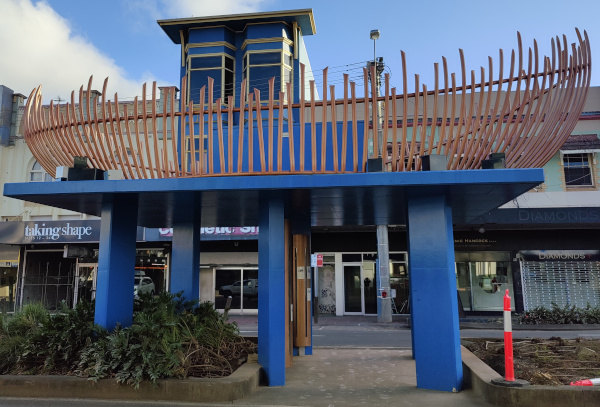I've seen fire and I've seen rain
I've seen sunny days that I thought would never end
I've seen lonely times when I could not find a friend
But I always thought that I'd see you again
… Won't you look down upon me, Jesus?
You've got to help me make a stand
You've just got to see me through another day
My body's aching and my time is at hand
And I won't make it any other way
Fire and Rain, James Taylor, 1974
When it was installed people joked that Lismore’s ‘ark’ wouldn’t repel floodwater.
It didn’t, nor did the flood levee built at far greater cost.

Mrs A stood chest deep in water from midnight to 4.00 pm the next day when the family finally convinced someone to look for her. A young man on his kayak found her and organised the rescue boat.
Mr B, aged 90, was able to get up into the ceiling space as the waters rose. Mrs B was too weak to get through the manhole and stood on the table in the water. They were both found alive, badly shaken, but alive.
Mr C got on the bed with the dog and waited. If the water got above the windowsill they would drown. It only got to the power point.
Mr D lost his accommodation in North Lismore. He worked without a break at the Southern Cross University emergency centre for 10 days and then asked staff if he could borrow a clipper so he could go off somewhere private and cut his toenails.
Ms E got water under the house. She was cleaning up with friends when she collapsed and could not be resuscitated. She was dead on arrival at Lismore Base Hospital.
There are thousands of such stories from the Lismore flood of 2022, ranging from the banal to the tragic, all demonstrating the responses of a community thrown into chaos by a natural disaster.

Lismore knows floods. You pack up your stuff and put it above the once-legendary 1974 flood level, the heights of which were marked by plaques on lamp-posts and buildings around the city. Then you get up on the roof and wait. If you’re confident you crack open a case of Tooheys.
This was different. The flood was fast and furious, wreaking havoc far and wide on houses and businesses thought to be above the highest flood level. It was an ‘unprecedented’ disaster (and subsequently declared a national disaster by the prime minister) with some people losing their lives and many their personal history and memorabilia. For so many their belongings were literally washed down the river.
Lismore looked like a war zone:- hundreds in the emergency centres, tears and fears for loved ones and many examples of heroism.
Perhaps the main visible difference from the Ukraine war - happening concurrently, half a world away - was that the buildings looked relatively untouched. It was the contents that were destroyed and the remnants subsequently disgorged onto the street.

Emergency services were overwhelmed. The magnitude of the disaster far exceeded their capabilities. It was the work of thousands of fellow members of the community getting in their boats, canoes and kayaks that rescued the vast majority. A fact that was subsequently acknowledged by the politicians and the leaders of community services and military.
The volunteers were not just local. On the medical front, nurses, ambulance officers, doctors and psychologists came from around the country to lend a hand. The surviving pharmacies on the hill kept the medical supplies stocked at the evacuation centres.

Donations of food, clothing and bedding poured in. Even the mobile laundromats turned up in force to keep the centres functioning.

The Salvos organised meals at the evacuation centres and the Sikhs from Melbourne came to feed the hungry, not least the gluten intolerant and
vegetarian.
 |
 |
The veterinarians in central Lismore were smashed, with those on the plateau providing services to the many animals that were in dire need or had been rescued.
The animal hospital at the rescue centre was manned during daylight hours by voluntary vet nurses and the flying vet was available for assistance with stranded animals.

The pollies came and saw. People were angry and wanted restitution but all knew the extent of the damage meant that could never be. Support from State and Federal governments was generous but will barely touch the surface of what will be needed.
Steve Krieg, the recently elected mayor of Lismore, looked spent. He has lost his house and both of his businesses but had to struggle on with his electoral duties. It was a baptism of fire or, in this case more accurately, flood. Speaking on behalf of the community he was thankful for the support received from the NSW premier but was perplexed by the slowness of the national emergency services to respond.
Surrounding areas were cut for a week, with many collapsed roads and washaways. Power was off in many areas for days and even those who had it found, it was not reliable. The phone system was overwhelmed, with large areas having no fixed or mobile coverage. For a week the net was down, so no Netflix to provide distraction..
Flooding has been part of Lismore’s history since its inception. In an accompanying article Robin Osborne (no stranger to floods) looks back on the flooding that has affected the city for over 160 years and ponders the future of the town.
Lismore, named after its counterpart in County Waterford, Ireland (which also has a St Carthage’s cathedral) was badly affected by the 2017 flood and commerce on the town's main “block” had not recovered in the intervening five years. Many shop fronts remained vacant due to weak demand. Newsagents are largely a thing of the past and bank branches have become fewer as people move to online shopping, accelerated by the COVID-19 pandemic. There’s no doubt that even before 2022’s ‘big one’ , commercial retail in Lismore was struggling.
On the up-side, however, personal services were thriving - Lismore was becoming a hub for hairdressers and barbers, mani- and pedi-curists, yoga enthusiasts and those seeking a relaxing massage.
How on earth can we avoid this devastation again? Moving the city centre to higher ground is debated after each flood. The Director of the National Recovery and Resilience Agency, Shane Stone, said people should be prohibited from building in flood or fire zones, saying this is the only long term solution, but was roundly criticised for putting his views in such a seemingly critical manner.
The 2005 Lismore levee at 10.65 metres has helped prevent minor flooding of the CBD but is no match for the “one in 100 years flood” that is occuring at increasingly frequent intervals.

As Robin Osborne notes there is limited high ground around Lismore for commercial development and there would be significant legal issues in preventing citizens from returning to their homes on the land they legally own.
Former and current mayors, as well as many members of the community, are opposed and want the town rebuilt. Splitting the town into a number of satellite communities would likely fragment and weaken the Lismore community.
Making new buildings more flood resistant is one option. Many houses were washed off their footings in the 1954 flood and the change to building regulations to prevent recurrences have been largely successful. There’s some precedent with Darwin, post-Cyclone Tracy.
However, options to make buildings flood resistant are limited and apart from concrete and tile constructions are doomed to failure when the flood waters go over the roof.
The failure to predict the flood height was heavily criticised by the community. Those who experienced previous floods recall that the rainfall in the catchment areas was phoned through every hour to a central coordinator who would give his latest estimate of flood peak and time. Modern technology and central coordination replaced this model years ago but was clearly no match for predicting the speed and the flood height of two years of La Nina wet weather.
Also failed was the co-ordination of thousands of volunteers who came to help and who were critical to saving lives in the first 24 hours. Emergency services and telecommunications were overwhelmed by those in need and their concerned family and friends.
Given that these catastrophes will occur more frequently in future and that the first responders are likely to be local community members some forethought should be given to better coordination of the rescue effort. Doing things “by the book” may reduce an organisation’s culpability when things go wrong but proved woefully under-resourced when doing it “right”.
Nordocs is holding a meeting on 2 April 2022 at the Goonellabah Workers Sports Club to consider the effects of the Lismore 2022 flood on health practitioners and others. It is hoped that future Nordocs events may also consider how to mobilise medical resources in future emergencies.
Lismore will recover. The long term plan to move out of the floodplain started after previous floods has been completed by aged care, adopted by Council services and, enforced by planners, will be extended to other organisations.
In the short term some downtown businesses are already up and trading, if only with limited stock and reduced services. More will return over the next month.
There’s even a happy hour at the top bar of the Hotel Metropole between 4.00 and 9.00 pm and the beer is flowing. If you’re feeling generous you can even shout a round for Lismore, its businesses and workers.

Some images in this article were first posted to the Lismore Information Exchange FaceBook group by zeeclor, JasonLiang1, DaveArmstong1, PeterJQ1 andTraceyMichelle4.















